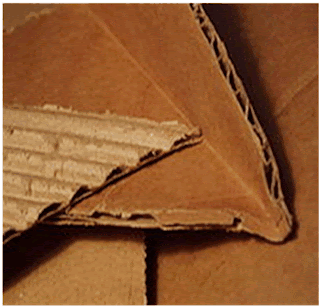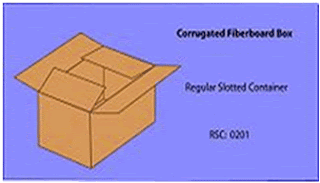Corrugated fiberboard is a paper-based material consisting of a fluted corrugated sheet and one or two flat linerboards. It is widely used in the manufacture of corrugated boxes and shipping containers.
The corrugated medium and linerboard are mad
e of containerboard, a paper-like material usually over 0.01 inches (0.25 mm) thick. Paperboardand corrugated fiberboard are sometimes called cardboard, although cardboard might be any heavy paper-pulp based board.
e of containerboard, a paper-like material usually over 0.01 inches (0.25 mm) thick. Paperboardand corrugated fiberboard are sometimes called cardboard, although cardboard might be any heavy paper-pulp based board.
History
In the mid-19th century, an ingenious concept enabled flimsy sheets of paper to be transformed into a rigid, stackable and cushioning form of packaging for delicate goods in transit. Corrugated (also called pleated) paper was patented in England in 1856, and used as a liner for tall hats, but corrugated boxboard was not patented and used as a shipping material until December 20, 1871. The patent was issued to Albert Jones of New York City for single-sided (single-face) corrugated board.Jones used the corrugated board for wrapping bottles and glass lantern chimneys. The first machine for producing large quantities of corrugated board was built in 1874 by G. Smyth, and in the same year Oliver Long improved upon Jones' design by inventing corrugated board with liner sheets on both sides.This was corrugated board as we know it today.
The Scottish-born Robert Gair invented the pre-cut paperboard box in 1890 – flat pieces manufactured in bulk that folded into boxes. Gair's invention came about as a result of an accident: he was a Brooklyn printer and paper-bag maker during the 1870s, and one day, while he was printing an order of seed bags, a metal ruler normally used to crease bags shifted in position and cut them. Gair discovered that by cutting and creasing in one operation he could make prefabricated paperboard boxes. Applying this idea to corrugated boxboard was a straightforward development when the material became available in the early twentieth century.
The corrugated box was initially used for packaging glass and pottery containers. Later, the case enabled fruit and produce to be brought from the farm to the retailer without bruising, improving the return to the producers and opening up export markets.
Manufactured of corrugated board
Corrugated board is manufactured on large high-precision machinery lines called corrugators, usually running at about 500 feet per minute (2.5 m/s) or more. These machines over time have become very complex with the objective of avoiding some common problems in corrugated board production, such as warp and washboarding.
The manufacturing process begins with pulping, the separation of wood (hardwood and sapwood) into individual fibers, as accomplished by mechanical methods or chemical treatment. In the classical corrugator, the paper is softened with high-pressure steam. After the board is formed it is dried in the so-called dry-end. Here the newly formed corrugated board is heated from the bottom by hot plates. On the top, various pressures are applied by a load system on the belt.
The corrugated medium is often 0.026 pounds per square foot (0.13 kg/m²) basis weight in the U.S.; in the UK, a 90 grams per square metre (0.018 lb/sq ft) fluting paper is common. At the single-facer, it is heated, moistened, and formed into a fluted pattern on geared wheels. This is joined to a flat linerboard with a starch based adhesive to form single face board. At the double-backer, a second flat linerboard is adhered to the other side of the fluted medium to form single wall corrugated board. Linerboards are test liners (recycled paper) or kraft paperboard (of various grades). The liner may be bleached white, mottled white, colored, or preprinted.
Common flute sizes are "A", "B", "C", "E" and "F" or microflute. The letter designation relates to the order that the flutes were invented, not the relative sizes. Flute size refers to the number of flutes per lineal foot, although the actual flute dimensions for different corrugator manufacuturers may vary slightly. Measuring the number of flutes per lineal foot is a more reliable method of identifying flute size than measuring board thickness, which can vary due to manufacturing conditions. The most common flute size in corrugated boxes is "C" flute.
Standard US corrugated flutes
Flute Designation | Flutes per lineal foot | Flute thickness (in) | Flutes per lineal metre | Flute thickness (mm) |
A flute | 33 +/− 3 | 3/16 | 108 +/− 10 | 4.8 |
B flute | 47 +/− 3 | 1/8 | 154 +/− 10 | 3.2 |
C flute | 39 +/− 3 | 5/32 | 128 +/− 10 | 4.0 |
E flute | 90 +/− 4 | 1/16 | 295 +/− 13 | 1.6 |
F flute | 128 +/− 4 | 1/32 | 420 +/− 13 | 0.8 |
Corrugated fiberboard can be specified by the construction (single face, singlewall, doublewall, etc), flute size, burst strength, edge crush strength, flat crush, basis weights of components (pounds per thousand square feet, grams per square meter, etc), surface treatments and coatings, etc. TAPPI and ASTM test methods for these are standardized. The choice of corrugated medium, flute size, combining adhesive, and linerboards can be varied to engineer a corrugated board with specific properties to match a wide variety of potential uses. Double and triple-wall corrugated board is also produced for high stacking strength and puncture resistance.
Box manufacture process
Box Design
Packaging engineers design corrugated boxes to meet the particular needs of the product being shipped, the hazards of the shipping environment, (shock, vibration, compression, moisture, etc), and the needs of retailers and consumers.
The most common box style is the Regular Slotted Container (RSC). All flaps are the same length from the score to the edge. Typically, the major flaps meet in the middle and the minor flaps do not. The manufacturer's joint is most often joined with adhesive but may also be taped or stitched. The box is shipped flat (knocked down) to the packager who sets up the box, fills it, and closes it for shipment. Box closure may be by tape, adhesive, staples, strapping, etc.
The size of a box can be measured for either internal (for product fit) or external (for handling machinery or palletizng) dimensions. Boxes are usually specified and ordered by the internal dimensions. Box styles in Europe are typically defined by a 4-digit code specified by FEFCO: for example, a regular slotted container (RSC) is coded 0201. FEFCO styles are normally the basis for more complicated special designs that incorporate, for instance, locking tabs or internal fittings.
Manufacturing
Boxes can be formed in the same plant as the corrugator. Part of the scoring and cutting takes place in-line on the corrugator. Alternatively, sheets of corrugated board may be sent to a different manufacturing facility for box fabrication; these are sometimes called "sheet plants". The corrugated board is creased or scored to provide controlled bending of the board. Most often, slots are cut to provide flaps on the box. Scoring and slotting can also be accomplished by die-cutting.
The "Flexo Folder Gluer" is a machine that in one single pass prints, cuts, folds, and glues flat sheets of board to convert them to boxes for any application, from storing old family pictures to shipping the biggest of plasma TV sets to the global market. The most advanced of FFG's can run at speeds of up to 26,000 boxes per hour (about 433 per minute).Box styles in Europe are typically defined by a 4-digit code specified by FEFCO: for example, a regular slotted container (RSC) is coded 0201. FEFCO styles are normally the basis for more complicated special designs that incorporate, for instance, locking tabs or internal fittings.
single face laminate
A limitation of common corrugated material has been the difficulty in applying fine graphic print for informative and marketing purposes. The reasons for this stem from the fact that prefabricated corrugated sheets are relatively thick and spongy, compared to the thin and incompressible nature of solid fibre paper such as paperboard. Due to these characteristics of corrugated, it has been mainly printed using a flexographic process, which is by nature a coarse application with loose registration properties.
A more recent development popular in usage is a hybrid product featuring the structural benefits of corrugated combined with the high-graphics print of lithography previously relegated to paperboard folding cartons. This application, generally referred to as 'Single-Face Laminate', begins its process as a traditional fluted medium adhered to a single linerboard (single-face), but in place of a second long-fibered liner, a pre-printed sheet of paperboard such as SBS (solid bleached sulfate) is laminated to the outer facing. The sheet can then be converted with the same processes used for other corrugated manufacturing into any desired form.
Specialized equipment is necessary for the material construction of SFL, so users may expect to pay a premium for these products. However, this cost is often offset by the savings over a separate paperboard sleeve and the labor necessary to assemble the completed package. A limitation of common corrugated material has been the difficulty in applying fine graphic print for informative and marketing purposes. The reasons for this stem from the fact that prefabricated corrugated sheets are relatively thick and spongy, compared to the thin and incompressible nature of solid fibre paper such as paperboard. Due to these characteristics of corrugated, it has been mainly printed using a flexographic process, which is by nature a coarse application with loose registration properties.
A more recent development popular in usage is a hybrid product featuring the structural benefits of corrugated combined with the high-graphics print of lithography previously relegated to paperboard folding cartons. This application, generally referred to as 'Single-Face Laminate', begins its process as a traditional fluted medium adhered to a single linerboard (single-face), but in place of a second long-fibered liner, a pre-printed sheet of paperboard such as SBS (solid bleached sulfate) is laminated to the outer facing. The sheet can then be converted with the same processes used for other corrugated manufacturing into any desired form.
Recycling
Old corrugated containers are an excellent source of fibre for recycling. They can be compressed and baled for cost effective transport. The baled boxes are put in a hydropulper, which is a large vat of warm water for cleaning and processing. The pulp slurry is then used to make new paper and fiber products.
Mill and corrugator scrap, or broke, is the cleanest source for recycling. The high rates of post-consumer recycling reflect the efficiency of recycling mills to clean and process the incoming materials. Several technologies are available to sort, screen, filter, and chemically treat the recycled paper.
Many extraneous materials are readily removed. Twine, strapping, etc are removed from the hydropulper by a "ragger". Metal straps and staples can be screened out or removed by a magnet. Film-backed pressure sensitive tape stays intact: the PSA adhesive and the backing are both removed together.
Materials which are more difficult to remove include wax coatings on corrugated boxes and "stickies", soft rubbery particles which can clog the paper maker and contaminate the recycled paper. Stickies can originate from book bindings, hot melt adhesives, PSA adhesives from paperlabels, laminating adhesives of reinforced gummed tapes, etc. Corrugated fiberboard shredders are now available which convert post-consumer corrugated board into packing/cushioning materials by means of a specialized shredding process. Recycling corrugated fiberboard helps countries without sustainable wood resources build a paper and packaging industry locally.






2 comments:
folder gluer machine
Hi,
i gone through your website about folder gluer machine its really excellent.
you want additional about folder gluer machine please visit:http://www.boxtech.in
Thank you so much for visiting
Post a Comment